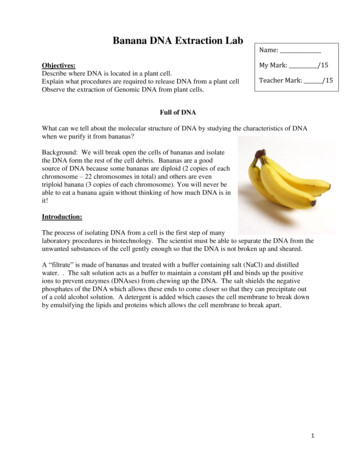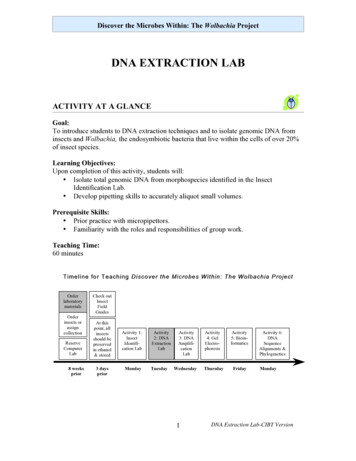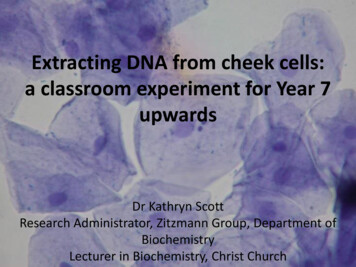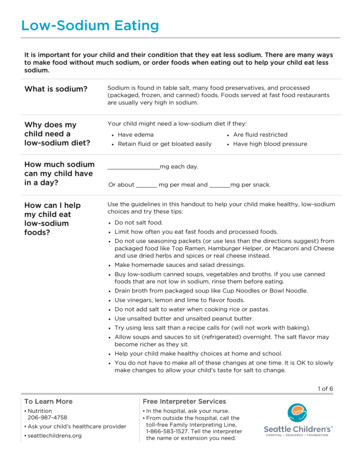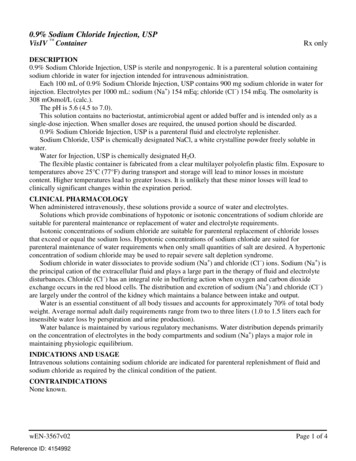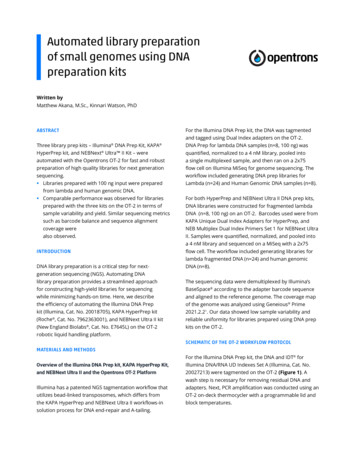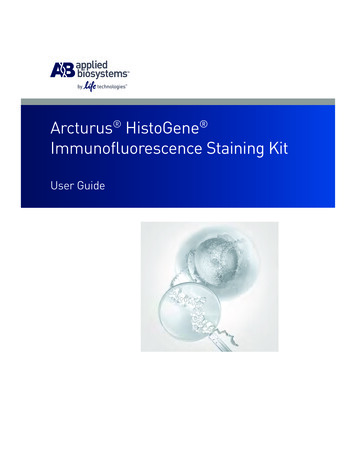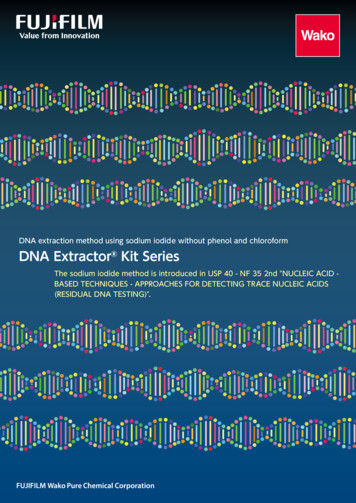
Transcription
DNA extraction method using sodium iodide without phenol and chloroformDNA Extractor Kit SeriesThe sodium iodide method is introduced in USP 40 - NF 35 2nd "NUCLEIC ACID BASED TECHNIQUES - APPROACHES FOR DETECTING TRACE NUCLEIC ACIDS(RESIDUAL DNA TESTING)".
A widely used method to extract DNA from tissues derived from living body is to precipitate and collect DNA using phenoland chloroform. However, this method requires the use of phenol and chloroform, hazardous substances.This DNA extraction method uses sodium iodide known as a chaotropic agent instead of these organic solvents.Sodium iodide has protein denaturation action and solubilization action. Sodium iodide releases chaotropic ions (I-) intothe solution; the ions increase water solubility of hydrophobic molecules in the sample, and its action to weakenhydrophobic bond contributes particularly to denaturation and solubilization of membrane proteins such as nuclear membrane.In addition, no solid phase extraction using silica carrier inhibits DNA loss by adsorption; moreover, the entire operation isperformed in a single tube, realizing a high yield rate.Features Organic solvents such as hazardous phenol and chloroform are not required. The entire process is performed in a single tube, causing no loss, contamination, or mechanical DNAdamage in operation. No solid phase extraction using silica carrier causes no loss by adsorption. Little oxidation damage to DNA and mechanical DNA damage A high yield rate is realized.1 The product series used in the accumulated total of 963 publications ** 1: Source: Google scholarList of DNA Extractor Kit series using the sodium iodide methodSample02Product NameFeaturesViral DNA in serum/biological productsDNA Extractor KitLow-cost, extraction of trace amount of DNAWhole blood (human, cow, horse),cultured cells, tissuesDNA Extractor WB KitCan extract high-molecular DNAGenomic DNA in serum/plasmaDNA Extractor SP KitCan remove blood-derived lipidsOxidative stress marker 8-OHdG DNADNA Extractor TIS KitInhibits DNA oxidation in extraction processBody hairs, nails, blood stains,saliva stain (forensic samples)DNA Extractor FM KitDNA extraction from trace amount of samples
Extraction of viral DNA in serum and an infinitesimal amount offungus-derived DNA in biological productsDNA Extractor KitWako Cat. No.295-50201This kit is to extract the whole trace amount of viral DNAin serum and fungus-derived DNA in biological products.A high yield of DNA with high purity can be obtained in ashort time without using hazardous phenol and chloroform.Please use DNA Extractor WB Kit or DNA Extractor WB-Rapid Kit when extracting genomic DNA from blood,cultured cells, or tissues.Package Size50 testsOperation time: 1 to 1.5 hoursSample amount: 100 μL/testFeatures I nfinitesimal amount of DNA (10 pg) can also be collectedat a high yield of about 90%. rganic solvents such as phenol and chloroform are not Orequired. The entire operation is completed in a single tube. operation is completed in a short time (1 to 1.5 Thehours).Extraction from serumSerum(100μL)Kit Contents [50 tests (sample 100 μL)]:Sodium N-Lauroyl Sarcosinate Solution /Glycogen Solution / Sodium Iodide Solution 300μL1. Sodium iodide solution. 26 mL 160 , 15 minutes2. Sodium N-Lauroyl sarcosinate solution. 1.2 mL 1Isopropanol 400μL3. Washing solution (A). 42 mL 1Room temperature, 15 minutes4. Washing solution (B). 40 mL 210,000 g, room temperature, 15 minutes5. Glycogen solution. 0.1 mL 1Precipitate Remove the supernatantWashing Solution (B) / Glycogen Solution 1mLPrinciple of DNA extraction10,000 g, room temperature, 5 minutei. Proteins and lipids in samples are made soluble with sodiumiodide and surfactant.Precipitate Remove the supernatantDry under reduced pressureii. Then, isopropanol is added to the samples to co-precipitateDNA with glycogen.DNAiii. At that time, the actions of sodium iodide, a chaotropic ion,and surfactant prevent the precipitation of components suchas proteins in the samples, resulting in selective precipitationof DNA and glycogen.DNA Extractor Kit DataRecovery rate of added DNA (%)Examples of using DNA Extractor KitDNA addition/recoverytest100Dilution ratio: 1121/10 1/102 1/103345161/10 1/102 1/103789λ/Hind III 10 to 1,000 pg waslabeled with 32P and addedto 100 μL of human serum.DNA was extracted using thisPCRkit and the recovery rate wasproductcalculated.8060402010 100502505001,000This methodPhenol methodDetection by PCRSerum containing hepatitisB virus (HBV) was diluted instages. DNA was extractedusing this kit and the phenolmethod. HBV-DNA wasamplified with PCR, and DNAwas detected using agarosegel electrophoresis.Lane 1: Marker DNA( φ X174/Hae III)Amount of DNA added (pg)ReferenceIshizawa, M. et al., Nucleic Acids Res., 19, 5792 (1991).03
Genomic DNA extraction from human whole blood sampleExtraction from cow/horse blood, cultured cells, and tissues is also possibleDNA Extractor WB KitHuman genomic gene analysis requires the preparationof high-molecular genomic DNA. Although many types ofgenomic DNA extraction methods are practiced at present,most of them use organic solvents such as phenol. Itstoxicity and extraction procedures requiring time and effortare the disadvantages.This kit is primarily for the extraction of genomic DNA fromhuman whole blood. A high yield of DNA with high puritycan be obtained in a single tube in a short time withoutusing hazardous phenol and chloroform.Wako Cat. No.291-5050250 testsOperation time: 1.5 hoursSample amount: 500 μL/testFeatures A high yield rate of high-molecular DNA of over 90% The entire process is completed in a single tube in about1.5 hours. Organic solvents such as phenol and chloroform are notrequired. Extraction from human whole blood as well as cow/horseblood, cultured cells, and tissues is also possible.Blood (0.5 mL) The operation is easier than the phenol/chloroformextraction method and suitable for processing multiplesamples.Lysis Solution 0.5mL10,000 g, 4 , 20 seconds The entire procedure is performed in a single tube,reducing genomic DNA damage by mechanical cutting inoperation.PrecipitateLysis Solution 1mL 2Package Size10,000 g, 4 , 20 secondsPrecipitateEnzyme Reaction Solution 0.2mLProtease Solution 10μLKit Contents [50 tests (sample 500 μL)]:1. Lysis solution. . 65 mL 237 , 1 hourCompletely dissolve the precipitateby tapping during the operation.Sodium Iodide Solution 0.3mLMix by inversionIsopropanol 0.5mL2. Enzyme reaction solution. 10 mL 13. Sodium iodide solution. 15 mL 14. Washing solution (A). 50 mL 15. Washing solution (B). 50 mL 110,000 g, room temperature, 10 minutesPrecipitateWashing Solution (A) 1mL10,000 g, room temperature, 5 minutes6. Protease. 10 mg 1Principle of DNA extractionPrecipitateWashing Solution (B) 1mLi. Cell membrane and cytoplasm are destroyed by surfactant,isolating cell nuclei.10,000 g, room temperature, 5 minutesii. The nuclear membrane and nuclear protein are decomposedby protease to expose DNA.PrecipitateDry under reduced pressureTE bufferGenomic DNA solutioniii. Protein and lipids are made soluble by the action of sodiumiodide, and DNA is precipitated with isopropanol.DNA Extractor WB Kit DataExamples of using DNA Extractor WB KitM1234M: Marker DNA (λ/Hind III)Lane 1: Undigested human genomic DNALane 2: Genomic DNA/BamH ILane 3: Genomic DNA/EcoR ILane 4: Genomic DNA/Hind IIIAgarose gel electrophoresis patternobtained through the digestion ofgenomic DNA derived from human wholeblood using this kit with various restrictionenzymes.Reference04Wang, L. et al., Nucleic Acids Res., 22, 1774 (1994).M123M: Marker DNA ( φ X174/Hinf I)Lane 1: 262 bpLane 2: 345 bpLane 3: 408 bpElectrophoresis was performed byPCR-amplifying genomic DNA derivedfrom human whole blood using this kit.Various size of human β-globin genewas PCR amplified using 1 μg ofgenomic DNA as a template.
Genomic DNA extraction from cow/horse whole bloodGenomic DNA with high purity can be efficiently extracted from cow/horse whole blood by partially changing the standard protocol. Proteasetreatment is performed for 2 hours for horse blood, whereas washingoperation with lysis solution is repeated 4 times for cow blood, followed bytreatment with protease for 4 hours.The operation time is about 3 hours for horse blood and 5 hours for cowblood.Blood samples used were added with EDTA·2Na or heparin as ananticoagulant agent.1234Electrophoretic image of genomicDNA extracted from cow/horseLane 1: λ/Hind IIILane 2: Horse blood (EDTA·2Na)Lane 3: Horse blood (Heparin)Lane 4: Cow blood (EDTA·2Na)Operation procedureExtraction from horse bloodTreatment with protease is performed for 2 hours until there is no nuclearpellet.Follow the standard protocol except for this operation.Extraction from cow bloodThis operation, which isolate cell nuclei and wash it by adding lysis solution,is repeated 4 to 5 times, because it is difficult to remove foreign substancessuch as hemoglobin only with 2 operations as described in the protocol.The reference is until the red pellets become transparent.Since pellets after centrifugation are very prone to peeling, sufficientattention is required in decantation.Also, perform treatment with protease for about 4 hours.Yield and purity of genomic DNA extracted from cow/horseSample3μL of 100 μL extracted DNA solution wasloaded on a 1% agarose gel and DNAwas separated by electrophoresis.DNA yield (μg/mL blood)A260/A280Horse (EDTA·2Na)56.621.91Horse (Heparin)48.341.88Cow (EDTA·2Na)22.041.86Notes) Each horse blood sample was collected from different horses.DNA extraction from tissuesGenomic DNA can be extracted from tissues by adding 2 to 3 simple operations to thestandard protocol. The operation is completed in about 2 hours.Resulting DNA has little contamination with RNA or protein and can be used in restrictionenzyme treatment, PCR, Southern blotting analysis, fingerprinting, etc.12345678Protocol (DNA extraction from tissues)50-100 mg of tissuesLysis Solution 1mLHomogenize10,000 g, 4 , 20 secondsExamples of rat gene detection by PCRRat GAPDH gene fragment (983 bp) wasamplified using DNA extracted from each rattissue as a template. 983bpA band of 983 bp could be detected in allDNAs extracted from each tissue.Lane 1: Marker DNA( φ X174/Hae III)Lane 2: StomachLane 3: IntestineLane 4: LiverLane 5: PancreasLane 6: Skeletal musclesLane 7: Negative controlLane 8: Positive controlPrecipitateLysis Solution 1mLTwiceMicrotube mixer, 30 seconds10,000 g, 4 , 20 secondsPrecipitateEnzyme Reaction Solution 200μLRNase 20μg/mLIncubate, 50 , 10 minutesProtease 10μLIncubate, 50 , 60 minutes10,000 g, room temperature, 5 minutesSupernatantSodium Iodide Solution 0.3mL, Mix by inversionIsopropanol 0.5mL, Mix by inversion10,000 g, room temperature, 10 minutesYield and purity of DNA extracted from each rat tissue using this kitTissuesDNA yield (μg/100 mg of er2861.95Pancreas6241.95Skeletal muscles671.85Despite of variations in DNA yield per unit of tissues, DNA with high purity could be extracted.PrecipitateWashing Solution (A) 1mL, Mix10,000 g, room temperature, 5 minutesPrecipitateWashing Solution (B) 1mL, Mix10,000 g, room temperature, 5 minutesPrecipitateDry under reduced pressure, 2 minutesTE buffer 100-200 μLDNA solution05
Q&A for DNA Extractor WB KitQ1. What is the principle of DNA Extractor WB Kit? This kit is for the extraction of genomic DNA from whole bloodand cultured cells. Only cell nuclei are collected by adding a lysissolution containing surfactant first. Next, the nuclear membraneand foreign substances are decomposed by protease to releaseDNA. Then, after protein is made soluble with sodium iodide,isopropanol is added to precipitate and collect genomic DNA only.Also, with this method, the whole DNA extraction process can beperformed in a single tube.Q2. Isn’t it contaminated with RNA? Although contamination with RNA is rare in extraction from wholeblood, cultured cells will be contaminated with RNA more or less.In this case, RNA can be almost completely removed by newlyadding the treatment with RNase at 37 C for 10 minutes to thebasic protocol.Q3. The yield rate of DNA is low. Why?The followings are the possible reasons.1. First centrifugation operation For the centrifugation operation at 10,000 g for 20 seconds,perform centrifugation for 20 seconds after the centrifugecompletely reached 10,000 g. Cell nuclei will not completelydetach in 20 seconds after the start button of the centrifuge ispressed; therefore, the DNA yield rate may drop by 20 to 30%.Although it varies by centrifuge, 10,000 g is equivalent toapproximately 12,000 rpm in case of a tabletop centrifuge. 2. Supernatant removing operation after centrifugation Perform all operations by decantation. Removal with a pipettemay result in a low yield of DNA.3. DNA dissolution As DNA in high concentration is extracted, add TE buffer (100200 μL) and slowly dissolve it at room temperature for 3 hours orat 4 C overnight. DNA will not be completely dissolved in a shorttime, which may result in an apparent low yield.Q4. Can DNA be extracted from 100 μL of blood? Yes. In this case, use the standard protocol by scaling it down.Also, when the amount of blood is 100 μL or less, add physiological saline to make up to 100 μL and perform the same procedure.One kit can be used 250 tests for 100 μL of blood.Q5. Can DNA be extracted by using heparin as an anticoagulantagent instead of EDTA? DNA can be successfully extracted at a usual concentration ofheparin (10 units/mL of blood) or less, but the yield rate markedlydecreases from a concentration of around 20 units/mL. Also, DNAextracted from blood added with heparin may affect restrictionenzyme treatment or PCR reaction. Therefore, the use ofEDTA·2Na or EDTA·2K (1 mg/mL of blood) is recommended.Q6. Can DNA be extracted from stored blood? DNA can be extracted successfully if blood is stored at 4 C for3 weeks or less. However, in case of a long-term storage of 1month or more, DNA will be gradually decomposed. Blood shouldbe stored frozen in case of long-term storage.Q7. What should be done without a microtube mixer?Mix the sample by inversion for about 1 to 2 minutes.Q8. We want to suspend the experiment. Store the precipitate separated by centrifugation with the additionof lysis solution at -20 C.Q9. We do not have a refrigerated centrifuge. Extraction can be performed with a tabletop centrifuge. In thatcase, perform the operation quickly.06Q10. How much DNA can be extracted from 1 mL of blood? Although there are variations by sample, approximately 20 to 70μg of DNA can be extracted from normal humans.Q11. Can DNA be extracted from tissues with this kit? Yes. DNA can be extracted by fragmenting tissues byhomogenization.Q12. What is the initial cell number when extracting DNA from culturedcells?36 10 to 10 cells will be enough for extraction. Cultured cells will becontaminated with RNA; therefore, before treatment with protease, add 20 μg/mL of RNase A and treat at 37 C for 10 minutes.Q13. Can mitochondrial DNA be extracted?Yes. Please see the following publication. Kubota, N., Hayashi, J., Inada, T. and Iwamura, Y.: RadiationResearch, 148, 395 (1997). For the extraction of mitochondrial DNA alone, the use of mtDNAExtractor WB Kit (Wako Cat. No. 293-54401) and mtDNAExtractor CT Kit (Wako Cat. No. 291-55301) is recommended.Q14. What are the differences from DNA Extractor Kit (Wako Cat. No.295-50201)? The purpose of use is different. DNA Extractor Kit is for theextraction of a slight amount of viral DNA (DNA virus such ashepatitis B virus) in serum and a slight amount of fungus-derivedDNA in biological products, while DNA Extractor WB Kit specifically extracts genomic DNA from whole blood and cultured cells.Q15. How should protease be stored after prepared?It is stable at -20 C for 6 months.Q16. What are the differences from DNA Extractor WB-Rapid Kit? DNA Extractor WB-Rapid Kit is an improved product to enableDNA extraction in about 20 minutes. It is suitable for treatingmany samples in a small volume.Q17. Some insoluble matters still remain after treatment with proteaseat 37 C for 1 hour. What should be done? Failure to digest in an hour is considered attributable toinsufficient washing with lysis solution in the first step. When cellnuclei are precipitated in the beginning, repeat washing until redpigment derived from hemoglobin is eliminated.Q18. When DNA extraction from cultured cells was performed, whiteinsoluble matters emerged at the time of adding sodium iodide.Should we move on to the next step after removing thesematters? Insoluble matters may be observed depending on types ofcultured cells. In this case, there is no problem to move to thenext step, washing operation with washing solution (A), withoutremoving the matters. Insoluble matters will be dissolved byadding washing solution (A). If the purity of resulting DNA is low, itis recommended to repeat the operation of cell nuclei precipitationby lysis solution.Q19. The A260/A280 ratio of DNA is 1.8 or below. What should be done? Sodium iodide may be remained in DNA. In this case, repeatwashing with washing solution (B).Q20. Is there any reference literature? See the following reference: Wang, L., Hirayasu, K., Ishizawa, M.and Kobayashi, Y.: Nucl. Acids Res., 22, 1774 (1994).
Genomic DNA extraction from serum and plasmaDNA Extractor SP KitWako Cat. No.296-60501This kit, an improved version of DNA Extractor Kit, is aDNA extraction kit optimized for the extraction of DNAfragments in serum or plasma. It can obtain a very highDNA yield, so is useful as a pretreatment reagent to detectand analyze the target gene with a high sensitivity. Also,this product uses the sodium iodide method without usingorganic solvents such as phenol and chloroform.Package Size50 testsOperation time: 1 hour or moreSample amount: 100 μL/testFeatures DNA can be obtained at a high yield rate from a smallamount (100 μL) of serum and plasma sample. “Sodium iodide method” achieving nearly 100% yield rateis adopted. Organic solvents such as phenol and chloroform are notrequired.Methods100μL (200μL)*1Serum or plasma No use of solid phase extraction method using silicacarrier realizes a high yield of DNA.*2 High-quality DNA suitable for PCR can be obtained.Enzyme Reaction Solution 200μL (300μL) Lipids, etc., derived from blood sample can be completelyremoved with specially prepared alcohol solution includedin the kit.Protein Digestion Solution 5μL (8 10μL)*3VortexIncubate 56 , 10 minutes (56 , 30 minutes)Sodium Iodide Solution 300μL (400μL)Gently mixAlcohol Solution 600μL (900μL) The entire operation is completed in a single tube.Kit Contents [50 tests (sample 100 μL)]:VortexRoom temperature, 10 minutes1. Enzyme reaction solution. 10 mL 112,000 - 20,000 g, room temperature, 10 minutesPrecipitate2. Protein digestion solution. 250 μL 1*4Washing Solution (A) 1mL (1.5mL)3. Sodium iodide solution. 15 mL 1*54. Alcohol solution. . 30 mL 1Vortex12,000 - 20,000 g, room temperature, 5 minutes*6Precipitate6. Washing solution (B). 50 mL 1*4Washing Solution (B) 1mL (1.5mL)Vortex *612,000 - 20,000 g, room temperature, 10 minutesPrecipitate5. Washing solution (A). 50 mL 1Principle of DNA extraction*4Dry, 65 , 5 minutesTE buffer(10 20μL)Vortex*6Dissolve, 65 , 3-5 minutesVortex *7DNA solution Store at -20 i. Protein derived from serum/plasma is decomposed byprotease.ii. Protein and lipids derived from serum/plasma are madesoluble by the action of sodium iodide and removed withalcohol solution included in the kit to precipitate DNA.* 1 The protocol starting with 200 μL of sample is shown in the parentheses.* 2 Handle serum (plasma) samples on the ice. Add enzyme reaction solution as early aspossible so that DNase in serum (plasma) will not be activated.* 3 Take it out of the kit and transfer it on the ice before use.* 4 Discard the supernatant, place the tube upside down on a paper towel, and removeremaining supernatant by pressing the mouth of the tube to the paper towel.* 5 After washing solution (A) is added, the sample can be stored for a long term at -20 C.* 6 Mix well until the precipitate peels off from the wall of the tube.* 7 Dissolve completely until there is no precipitate.References1) Ishizawa, M. et al., Nucleic Acids Res., 22, 1774 (1994).2) Sozzi, G. et al., Clin. Cancer Res., 5, 2689 (1999).3) Silva, J. M. et al., Cancer Res., 59, 3251 (1999).4) Shao, Z. M. et al., Clin. Cancer Res., 7, 2222 (2001).07
DNA Extractor SP Kit DataExamples of using DNA Extractor SP KitAmplification of p53-Exon 5 region of DNA extracted from human serum and plasmaUsing this kit, DNA was extracted from human serum (10 samples) and human plasma (1 sample) and dissolved in 20 μL of TE buffer (pH 8.0) to prepareDNA samples. The p53-Exon 5 region (308 bp) was amplified from 5 μL of each sample.The kit was compared with DNA extraction kit (Company A) which is based on the extraction principle with silica carrier (centrifugal filtration method) ascontrol.Serum 1 Serum 2 Serum 3 Serum 4 Plasma Serum 5 Serum 6 Serum 7 Serum 8 Serum 9 Serum 10M WAWAWAWA WAWAWAWA WAWAWAM: DNA Step Ladder Mix (80-10 kbp)W: DNA Extractor SP KitA: Kit of Company A 308bpPCR: 40 cycles3% AgaroseMethod of extracting DNA from 1 to 5 mL sample using DNA Extractor SP KitAfter dissolving in TE buffer, insoluble matters were precipitated and absorption was detected in the background (absorbance 320 nm), indicating lower puritythan the standard method (extraction from 100- 200 μL). However, amplification by PCR can be performed successfully.Method for treating 1 mL serum (plasma) sample1 mL sample/15 mL centrifuge tube7.5mL Enzyme Reaction Solution50μL Protein Digestion Solution250μL Protein Digestion Solution56 , 30 minutes56 , 30 minutes3mL Sodium Iodide Solution10mL Sodium Iodide Solution6mL Alcohol Solution22.5mL Alcohol SolutionRoom temperature, 15 minutesRoom temperature, 15 minutes10,000 rpm, 20 minutes10,000 rpm, 20 minutes38mL Washing Solution (A)10,000 rpm, 10 minutes10,000 rpm, 10 minutesPrecipitate10mL Washing Solution (B)38mL Washing Solution (B)10,000 rpm, 10 minutes10,000 rpm, 10 minutesPrecipitate(Dissolve in an appropriate amount of TE, etc.)5mLNCM308bp Precipitate10mL Washing Solution (A)Precipitate1mL5 mL sample/50 mL centrifuge tube2mL Enzyme Reaction SolutionPrecipitate08Method for treating 5 mL serum (plasma) samplePrecipitate(Dissolve in an appropriate amount of TE, etc.)NC: Negative ControlM: MarkerThe p53-Exon 5 region (308 bp) samples forPCR (35 cycles). Of DNA extracted from 1 mLand 5 mL of serum, DNA equivalent to 10 μLof serum was applied to PCR. The target DNAsequence was successfully amplified.
DNA extraction for 8-OHdG measurementDNA extraction from human and animal parenchyma tissuesDNA Extractor TIS KitWako Cat. No.296-67701The sodium iodide method, the basic principle of DNA Extractor Kit series,is known as a DNA extraction method causing relatively little oxidationduring operations. This kit further inhibits oxidation of DNA with the use ofan oxidation inhibitor and is useful for the measurement of 8-OHdG(8-hydroxy-2'-deoxyguanosine), an oxidative stress marker.MethodsProtocol 1Protocol 2 * 1Approximately 150 mg of tissuesApproximately 150 mg of tissuesLysis Solution 1mLLysis Solution 1mLHomogenize6,000 g, 4 , 10 minutesPrecipitatePrecipitateLysis Solution 1mL6,000 g, 4 , 10 minutes6,000 g, 4 , 10 minutesPrecipitateEnzyme Reaction Solution 2300μLEnzyme Reaction Solution*2300μLProtein Digestion Solution 15μLOxidation Inhibitor 3μLVortex37 , 10 minutesOxidation Inhibitor 3μLVortex37 , 1 hour (Vortex every 20 minutes)10,000 g, room temperature, 5 minutesSupernatant/1.5 mL tubeAlcohol Solution 600μL10,000 g, room temperature, 10 minutes70%EtOH 1mL10,000 g, room temperature,5 minutesPrecipitate (nucleic acid)PrecipitateDissolve in DDW or TE buffer5. Oxidation inhibitor.350 μL 16. Sodium iodide solution. 15 mL 17. Alcohol solution. . 30 mL 18. PEG solution. 20 mL 1Sodium Iodide Solution 300μLPrecipitatePrecipitate(DNA)4. Protein digestion solution.750 μL 110,000 g, room temperature, 10 minutesSodium Iodide Solution 300μL10,000 g, room temperature,5 minutes3. RNase solution. 50 μL 1Alcohol Solution 600μLSupernatant/1.5 mL tube70%EtOH 1mL Useful for the detection and measurement of oxidative stress markers. Sodium iodide method causes littleoxidation of DNA during operation. The use of oxidation inhibitor furtherinhibits oxidation of DNA.2. Enzyme reaction solution. 15 mL 1RNase Solution 1μLProtein Digestion Solution 15μL37 , 1 hour (Vortex every 20 minutes)10,000 g, room temperature, 5 minutesFeatures1. Lysis solution. . 75 mL 2Precipitate*2Sample amount: 100 μL/testKit Contents [50 tests (sample 100μL)] :Lysis Solution 1mL 2Operation time: 2 hours or more Suitable for DNA extraction from humanand animal parenchyma tissues.Homogenate/2 mL tube6,000 g, 4 , 10 minutes50 tests Organic solvents such as phenol andchloroform are not required.HomogenizeHomogenate/2 mL tubePackage Size 2 2TE buffer 400 μLRNase Solution 1μLOxidation Inhibitor 4μL37 , 30 minutes (Vortex every 10 minutes)PEG solution 400 μL10,000 g, 4 , 10 minutesPrecipitate70%EtOH 1mL10,000 g, 4 , 5 minutesPrecipitate (DNA)Dissolve in DDW or TE bufferProtocol 1 is a simplified method where treatment with RNase is performed before treatment with protease.Protocol 2 is a method to collect DNA by polyethylene glycol (PEG) precipitation method where protease treatment and RNase treatment are performed in differentprocesses to enhance the purity of DNA.There is no difference in the amount of 8-OHdG between the two methods, and the levels of DNA oxidation inhibition are comparable.* 1 DNA purity can be enhanced with this protocol.* 2 If there is any deposit in enzyme reaction solution, completely dissolve the deposit by heating it to 37 C or returning it to room temperature and mix before use.09
DNA Extractor TIS Kit DataDNA extraction from mouse liver and 8-OHdG measurementDNA was extracted from mouse liver (the same mouse) using DNA Extractor WB Kit [Wako Cat. No. 291-50502] and DNA Extractor TIS Kit [Protocol 1].Resulting DNA was treated with nuclease P1, the amount of 8-OHdG was measured by High Sensitive 8-OHdG Check [Wako Cat. No. 307-07921] and HPLC/ECD, and two methods were compared.Measurement by HighSensitive 8-OHdGCheckAmount of 8-OHdG (pg/μg DNA)2.01.81.6The amount of 8-OHdGgenerated during operationcould be reduced to halfas compared with DNAExtractor WB Kit.As a result, the kit showedsuperior performance asa DNA extraction kit for8-OHdG measurement.1.41.21.00.80.60.40.20.0Measurement by HPLC/ECDdG concentration(µmol/L)8-OHdG/105 dGDNA Extractor WB Kit1.416870.21DNA Extractor TIS Kit0.596920.08[HPLC conditions]Column: Wakosil-II 5C18 RS φ 4.6 mm 150 mmEluent: 50 mmol/L sodium acetate (pH 5.2), 9% MeOHFlow rate: 1 mL/minAbsorbance: UV 260 nmECD electrolytic potential: 600 mVDNAExtractor TIS KitDNAExtractor WB Kit8-OHdG concentration(nmol/L)The amount of 8-OHdG generated during operation can be reduced to half or less ascompared with DNA Extractor WB Kit.Also, the level of 8-OHdG in deoxyguanosine has been revealed to be very low,showing superior performance as a DNA extraction kit for 8-OHdG measurement.8-OHdG AssayPreparation Reagent SetWhen measuring 8-OHdG in tissues, extracted DNA fromtissues need to be hydrolyzed. This product is a reagent kitincluding enzyme, buffer, etc., used in pretreatment of 8OHdG measurement.Add a specified amount of each reagent to DNA samples formeasurement to promote reaction, thereby reducing variability in the nuclease treatment status (mononucleotide release)and realizing stable measurement of 8-OHdG.292-67801ManufacturerCat No.Product namePackage Size307-07921KOG-HS10/EHigh Sensitive8-OHdG Check96 tests301-06101KOG-200S/ENew 8-OHdGCheck1 set50 testsKit Contents [50 tests]:1. Acetic acid buffer. 950 μL 12. Nuclease P1. 500 units 13. Tris buffer. 1 mL 14. Alkaline phosphatase solution. 50 μL 1MethodsDNA sample 200μg/150μL DDWThis is an ELISA kit used to determine 8-OHdG amount, a biomarker of DNAoxidative damage.NIKKEN SEIL Co, Ltd.Treatment by boiling 98 , 2 minutesRapid cooling (on ice), 5-10 minutesAcetic acid buffer 19 μLNuclease P1 solution 10 μL37 , 30 minutesTris buffer 20μLAlkaline phosphatase solution 1 μL37 , 30 minutes10,000 MW ultrafiltration(spin filtration 15,000 g, 20
This kit is to extract the whole trace amount of viral DNA in serum and fungus-derived DNA in biological products. A high yield of DNA with high purity can be obtained in a short time without using hazardous phenol and chloroform. Please use DNA Extractor WB Kit or DNA Extractor WB-Rapid Kit when extracting genomic DNA from blood,
